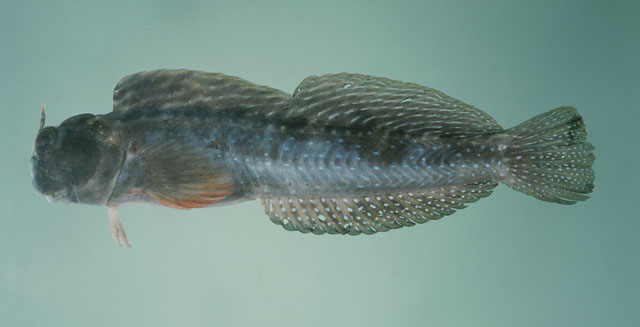| Blenniidae (Combtooth blennies), subfamily: Salariinae |
| 15 cm TL (male/unsexed); 10.6 cm SL (female) |
|
reef-associated; brackish; marine |
| Western Pacific: Queensland to western Australia (Ref. 2334). |
|
Dorsal spines (total): 12-14; Dorsal soft rays (total): 17-21; Anal spines: 2; Anal soft rays: 17-21. Dorsal fin XII-XIV, 17-21; notched membrane between spinous and segmented-ray of the dorsal fin >75% the length of the first segmented ray; posterior membrane from posteriormost ray beginning somewhere between the dorsal edge of caudal peduncle, anterior to caudal-fin base, to dorsal margin of caudal fin <15% of caudal-fin length, typically on caudal peduncle, rarely posteriorly past the vertical at caudal-fin base; segmented anal fin rays 17-21; pectoral-fin rays 12-15; vertebrae 11 or 12+24 to 28 = 35-39 (usually 37 or 38); nape cirrus present or absent bilaterally or unilaterally, with slight variations between populations; orbital cirrus tree-like with medial and lateral branches; nasal cirri on rim of each anterior nostril short, palmate, with 2-8 branches (typically <6); bi-pored lateral-line tubes often more than 18; membrane from last dorsal-fin ray usually attached to caudal peduncle at or anterior to caudal-fin base; body with numerous small, pale spots; lateral line canal continuous antedorsally with simple pores (no vertical pairs of pores), extending posteriorly to point between verticals from 8th and 13th (rarely only to 8th) dorsal-fin spines, descending to midside and, in specimens >3 cm SL, continuing posteriorly as series of 6 to 26 short, disconnected, horizontally bi-pored canals/tubes in skin, numbering typically more than 10 and higher, proportional to SL; mandibular pores 4-6; lacking posterior canines; ventral margin of upper lip crenulate; no canine teeth present in lower jaw; both sexes with fleshy, blade-like crest on dorsal part of head; spinous- and segmented-ray portions of dorsal fin faintly to darkly dusky, often bearing dark, slender, oblique stripes (males) or dark spots (females). Largest male 11.8 cm SL; largest female 10.6 cm SL. With ophioblennius stage. |
| Adults occur along rocky and mangrove shores (Ref. 2334); in shallow depths and perhaps, under brackish or freshwater conditions (Ref. 9962). Oviparous. Eggs are demersal and adhesive (Ref. 205), and are attached to the substrate via a filamentous, adhesive pad or pedestal (Ref. 94114). Larvae are planktonic, often found in shallow, coastal waters (Ref. 94114). |
|
Least Concern (LC); Date assessed: 27 March 2009 Ref. (130435)
|
| harmless |
Source and more info: www.fishbase.org. For personal, classroom, and other internal use only. Not for publication.
